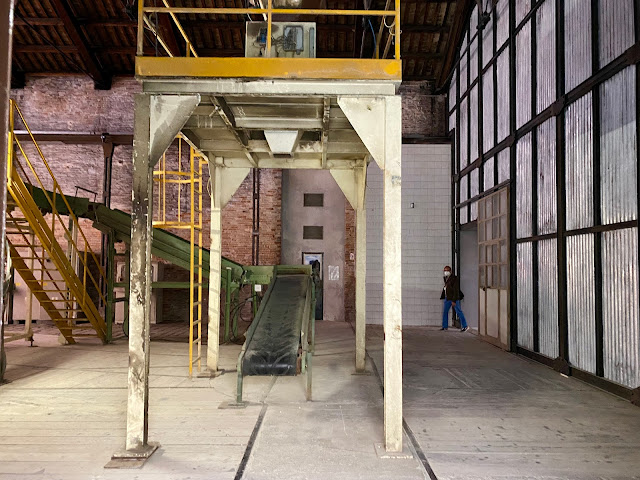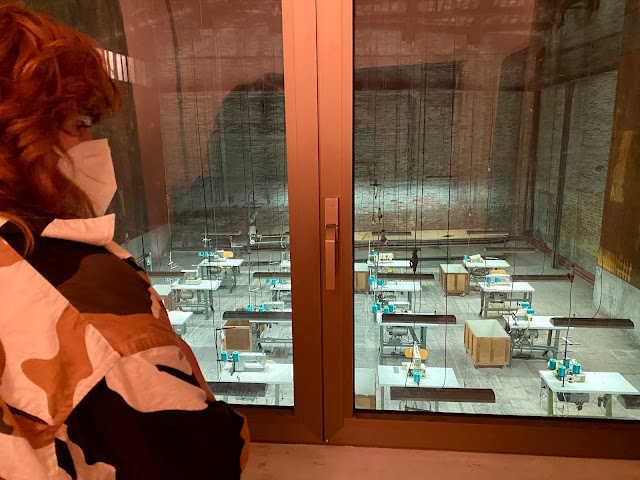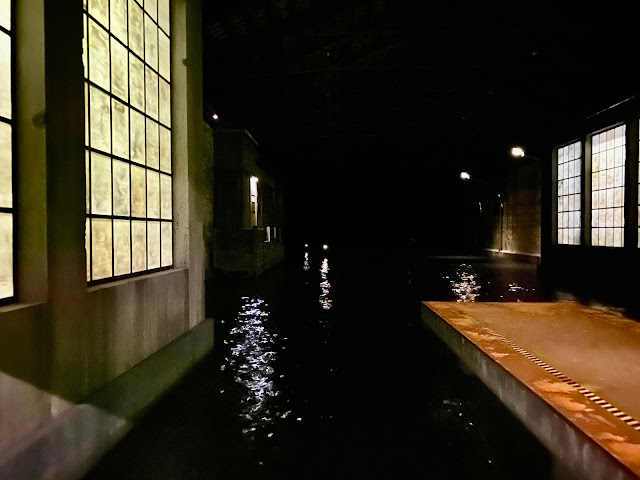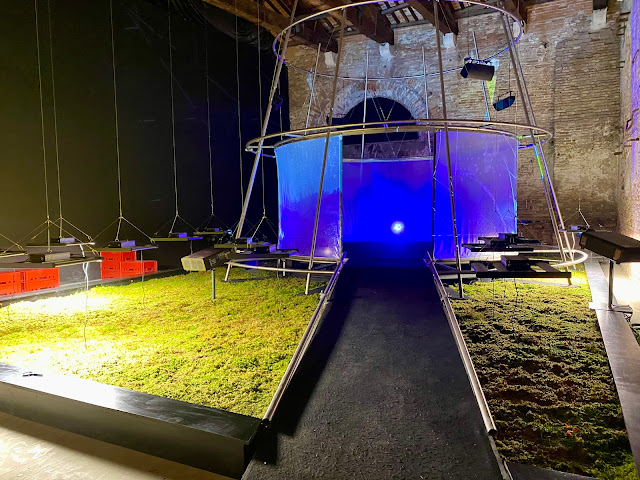La Biennale di Venezia - 59th International Art Exhibition
National Pavilions - Arsenale
Malta - Slovenia - Ukraine - Singapore - Ireland - Uzbekistain - Latvia
Malta Pavilion
Commissioner - Arts Council Malta
Curators - Keith Sciberras - Jeffrey Uslip
Exhibitors - Arcangelo Sassolino - Giuseppe Schembri Bonaci - Brian Schembri
Diplomazija Astuta
Diplomazija Astuta – including artists Arcangelo Sassolino, Giuseppe Schembri Bonaci, and Brian Schembri – reimagines Caravaggio’s seminal Maltese altarpiece The Beheading of Saint John the Baptist as a kinetic, sculptural installation. Through induction technology, molten steel droplets fall from the sky into seven rectangular basins of water, each representing a subject in The Beheading. By transposing the Oratory of the Decollato’s Zeitgeist onto the Malta Pavilion, Diplomazija Astuta resituates Caravaggio’s immanent themes within modern life, prompting viewers to negotiate an immersive space where the tragedy and brutality of Saint John’s execution is experienced in the present day, injustices of the past are reconciled, and shared humanist principles are upheld in the future.
Malta Pavilion
Slovenia Pavilion
Commissioner - Ales Vaupotic
Curator - Robert Simonisek
Exhibitor - Marko Jakse
Without a Master
Marko Jakse paints spaces of human imagination. Animals and strange creatures dominate over humans, existing species are joined by hermaphrodites and apparitions from fantasy islands, unknown expanses of the universe, or the future. Rich in oneiric undertones, Jakse’s art depicts paradoxical, antithetical entities relating to the symbols and relics of sunken civilisations, spirituality, religions, mythologies, and art heritage. His paintings challenge the idea of controlling nature and the related categories of existence, the scientific systems, and the knowledge of what is the primordial in and outside us; and above all, how something is. Jakse’s response to these questions covers a broad range from Nietzschean Dionysian abandon to metasymbolistic and metaromantic allegories reflecting the enthralling drama of human passions and yearning – mysterious games without a master.
Ukraine Pavilion
Commissioner - Kateryna Chuyeva - Deputy Minister for European Integration of the Ministry of Culture and Information Policy of Ukraine
Curators - Lizaveta German - Maria Lanko - Borys Filonenko
Exhibitor - Pavlo Makov
The Fountain of Exhaustion - Acqua alta
Pavlo Makov is an artist from Kharkiv whose practices in the early 1990s focused on exploring the parallels between the human body and urban landscape. The artwork The Fountain of Exhaustion, originally created in 1995, was intended as a paradoxical symbol of life: one river flows into another, and yet both become exhausted and run dry. Since then, the fountain has never been integrated into urban space and has never fully functioned as a processual object with actual water input. The project has only gained relevance over the last twenty-seven years, breaking free from the limiting context of the Eastern European metropolis of its birth and growing to stand for the global exhaustion of culture, economy, and politics. In view of the ongoing pandemic, it came to represent the accumulation of exhaustion.
Pavlo Makov
The Fountain of Exhaustion - Acqua alta
Singapore Pavilion
Commissioner - Rosa Daniel - Chief Executive Officer National Arts Council Singapore
Curator - Ute Meta Bauer
Exhibitor - Shubigi Rao
Pulp III: A Short Biography of the Banished Book
Taking the form of a book, film, and paper maze, Shubigi Rao’s exhibition Pulp III: A Short Biography of the Banished Book explores the persistence of endangered languages, the futures of public and alternative libraries, and the cosmopolitanism of regional communities that have blossomed and waned in historic centres of print and trade, including Venice and Singapore. The five thousand copies of Pulp Vol. III collected by La Biennale visitors will find their way across the world, germinating small libraries to resist erasure and circumvent geopolitical and cultural divides.
Shubigi Rao
Singapore Pavilion
Pulp III: A Short Biography of the Banished Book
Ireland Pavilion
Commissioner - Culture Ireland
Curator - Mary Cremin
Exhibitor - Eva Rothschild
The Shrinking Universe
The Shrinking Universe is an ambitious sculpture exhibition that sees Eva Rothschild moving into a terrain that is both authoritative and urgent, reflecting the current political crisis. Rothschild’s use of materials references urban dystrophy; the drifts of discarded objects allude to our consumer culture and lifestyles that adversely contribute to environmental damage. Graffitied boulders mimic border and urban defences, insinuating future ruins. This scene is juxtaposed with references to classical ruins of the past, reminders of utopian ideologies of both the ancient and modern worlds.
The Shrinking Universe
Uzbekistan Pavilion
Commissioners - Gayane Umerova - Art and Culture Development Foundation
Curators - Studio Space Caviar (Joseph Grima, Camilo Oliveira)
Sheida Gomashchi
Exhibitors - Charlie Tapp/Abror Zufarov - CCA Lab
Dixit Algorizmi: Garden of Knowledge
The Pavilion presents a reflection on the work of the scientist Muhammad ibn Musa al-Khwarizmi. His book Kitab Al-Jabr Wa-al-Muqabala, introduced to Europe under the title Dixit Algorizmi, was the first scientific text to present algebra as a discipline independent of geometry and arithmetic. This Latin transliteration of al-Khwarizmi’s name gave us the modern word algorithm. The “innovation acceleration” we consider particular to our time is assumed to be the product of a prevalently Western scientific tradition, but reality is more nuanced. It represents the apex of centuries of research spanning multiple civilisations. Dixit Algorizmi—Garden of Knowledge sets out to question the prevailing narrative around the histories and geographies of technological development, exploring forgotten roots and overlooked resonances with distant places, times, and cultures.
Dixit Algorizmi: Garden of Knowledge
Latvia Pavilion
Commissioner - Solvita Krese
Curators - Solvita Krese - Andra Silapetere
Exhibitors - Skuja Braden - Inguna Skuja - Melissa D. Braden
Selling Water by the River
Skuja Braden, an international artistic collaboration that was born in 1999 between Inguna Skuja from Latvia and Melissa D. Braden from California, presents a multilayered installation that maps the mental, physical, and spiritual areas within the artists’ home. The ideals and affiliations of its inhabitants are revealed, and insight is offered into different readings of the history of a region to test the readiness of its society to live up to the challenges of the present day. In the exhibition, home is echoed by images in porcelain, a material that Skuja Braden has mastered superbly. Their porcelain comes to life in everyday objects, fountains, bendy hoses, and male and female physiques and nature.
Selling by the River
Selling by the River
Virginia Overton
Virginia Overton’s site-specific sculptural installations explore the untapped potentialities of objects associated with industry and infrastructure. Her materials often include rope, car parts, trusses, lighting, lumber, logs, cement, as well as their attendant machines, such as cranes, pickup trucks, and gantries that hoist and move them. Her materials frequently behave performatively – modifying a site by obstructing, bisecting or echoing its inherent qualities. For The Milk of Dreams, Overton presents two sculptural works for the Arsenale, the heart of the Venetian naval industry since the early 12th century. The Untitled - Tulip - 2022 sculpture - above - comprises a large-scale tulip-like form. Cast from pre-existing molds typically used for architectural tunnels, three vertically interlocked concrete segments create an upright structure, dotted with circular pink glass “windows,” forming a triangular aperture to the sky.
Pin It



























